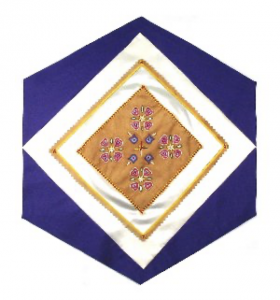Algonquin

The Block
The simple star pattern design, beaded and embroidered by Pauline Decontie, has a long and proud history. An elder, whose grandmother had used it to decorate moccasins vamps with naturally dyed porcupine quills and moose hair, gave the design to Pauline. The star is repeated four times around a Four Direction symbol, representing the cardinal points of a compass. This symbol and the number four are prominent themes among the Anishinàbe people. Algonquin oral culture talks about the four races — white, yellow, red, and black — and the need for cooperation among all people to respect and protect Mother Earth.
Cultural Profile
The Algonquian language family is the largest native-language group in North America, with many related languages and dialects. They refer to themselves as Anishinabeg meaning “the people”. However, not all speakers of Algonquian languages are necessarily Algonquin. Other First Nations people, the Abenakis, Ojibwe, Saulteaux, among others, speak languages belonging to the Algonquian linguistic family. The Algonquin (Algonkin), were a specific group of bands who called themselves Mamiwinini and lived in the Ottawa River Valley.
Historically they lived as semi-nomadic hunter-gatherers, travelling great distances in birch-bark canoes. Unlike their Iroquoian neighbours to the south and west, the Algonquin were not agricultural, being too far north to make it a viable option. Dependent on hunting and trapping for survival, they became renowned for their expert skills. During the summers various bands would come together at prime fishing locations. This was also a time for socialization. With the arrival of winters they would again break off into small hunting bands of extended family members to increase their chances of survival in the harsh climate.
In the early 17th century they became involved in the fur trade, often acting as middlemen between the French traders and the native peoples of the western Great Lakes region. The fur trade changed their lifestyle considerably, as they became more dependent on European trade goods. They acquired firearms and iron traps, making hunting easier and more prosperous. Increasingly, fabric became the material of choice for making clothing and shelter. By the 1800’s forestry operations had a devastating effect on Algonquin traditional hunting grounds, pushing the people further north.
The Algonquin now live in communities located in the Outaouais region of Québec, and the Ottawa River Valley. Their interests are managed and protected internally through specific programs and services. Their language has had a strong impact in the region, as is evidenced by the many native names given towns and villages.
Sponsor: Alison Wilson
